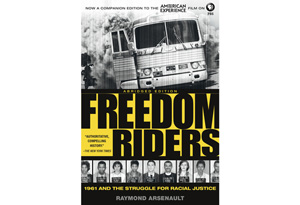Excerpt from Freedom Riders: 1961 and the Struggle for Racial Justice
Introduction

May 21, 1961. It was Sunday night on the New Frontier, and freedom was on the line in Montgomery, Alabama. Earlier in the evening, more than a thousand black Americans, including the Reverend Martin Luther King Jr. and several other nationally prominent civil rights leaders, had gathered at the First Baptist Church (Colored) to show their support for a visiting band of activists known as Freedom Riders. Located just a few blocks from the state capitol where President Jefferson Davis had sworn allegiance to the Confederate cause in 1861, First Baptist had been the setting for a number of dramatic events over the years. But the historic church had never witnessed anything quite like the situation that was unfolding both inside and outside its walls. For several hours the Freedom Riders and the congregation sang hymns and freedom songs and listened to testimonials about courage and commitment. But as the spirit of hope and justice rose inside the crowded sanctuary, a wholly different mood of defiance and outrage developed outside.
By nightfall the church was surrounded and besieged by a swelling mob of white protesters determined to defend a time-honored system of racial segregation. Screaming racial epithets and hurling rocks and Molotov cocktails, the protesters threatened to overwhelm a beleaguered group of Federal marshals who feared that some members of the mob were intent on burning the church to the ground. When it became obvious that the marshals were overmatched, the governor of Alabama deployed a battalion of National Guardsmen to disperse the crowd, and tragedy was averted. But it would be early morning before the surrounding streets were secure enough for the Freedom Riders and their supporters to leave the church. Loaded into a convoy of military trucks and looking much like wartime refugees, the troublesome visitors and their embattled hosts were escorted back to a black community that must have wondered what other indignities and challenges lay ahead. The battle of May 21 was over, but the centuries-old struggle for racial justice would continue.
By nightfall the church was surrounded and besieged by a swelling mob of white protesters determined to defend a time-honored system of racial segregation. Screaming racial epithets and hurling rocks and Molotov cocktails, the protesters threatened to overwhelm a beleaguered group of Federal marshals who feared that some members of the mob were intent on burning the church to the ground. When it became obvious that the marshals were overmatched, the governor of Alabama deployed a battalion of National Guardsmen to disperse the crowd, and tragedy was averted. But it would be early morning before the surrounding streets were secure enough for the Freedom Riders and their supporters to leave the church. Loaded into a convoy of military trucks and looking much like wartime refugees, the troublesome visitors and their embattled hosts were escorted back to a black community that must have wondered what other indignities and challenges lay ahead. The battle of May 21 was over, but the centuries-old struggle for racial justice would continue.
Reprinted from FREEDOM RIDERS: 1961 and the Struggle for Racial Justice by Raymond Arsenault with the permission of Oxford University Press. Copyright © 2006, 2011 by Raymond Arsenault.



